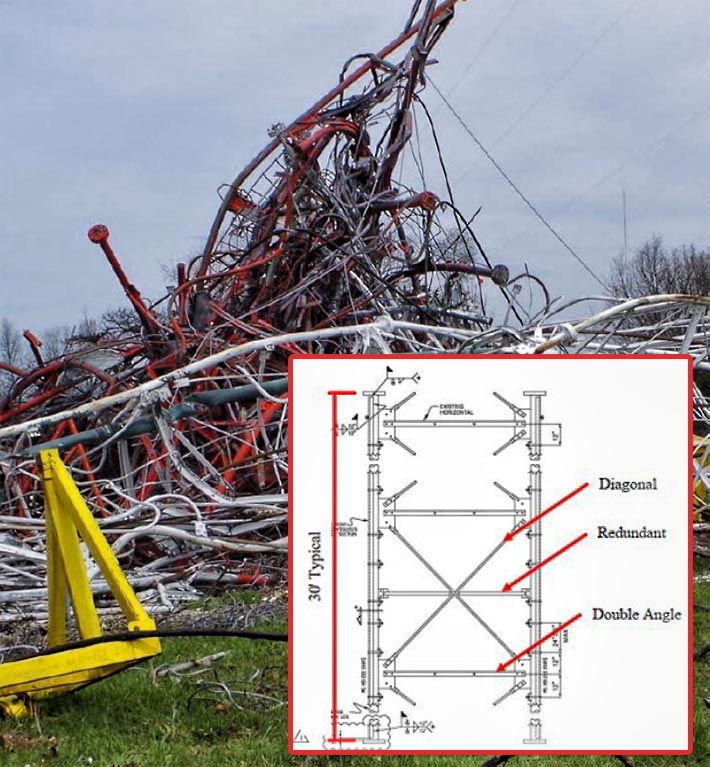
Inset photo details one of the drawings provided for the reinforcement project that ended in the death of Steve Lemay
The family of the owner of a tall tower erection company killed when a 1,891-foot TV tower collapsed near Fordland, Missouri in 2018 has filed a wrongful-death lawsuit against the Missouri State University Board of Governors (MSU) and South Carolina-based Tower Consultants, Inc. (TCI) who contracted with MSU to retrofit their structure as part of the FCC’s repacking effort.
Steve Lemay, 56, of Washington state, died when a tower used to broadcast KOZK Ozarks Public Television collapsed while Lemay’s crew was reinforcing the structure on April 19, 2018. His firm had been hired by TCI to perform the tower work.
On Thursday, Lemay’s wife and children filed a lawsuit claiming MSU which owned the tower, is liable for maintaining a “dangerous condition” on its property and that led to Lemay’s death.
The Lemays are asking for damages to compensate them for Lemay’s pain and suffering as well as medical, funeral and burial expenses.
The other defendants in the lawsuit are TCI’s President Jean Lecordier, Jiantao Yu, Moses Berry and William Barnhard, all agents and/or employees of TCI, according to the petition.
The Lemays are also suing Doug Sampson who they state managed the project for MSU.
The lawsuit says that on the day of the collapse, the tower began making a strange noise, and Lemay ordered his employees to get down as quickly as possible while he tried to determine what was going on (View video).
Shortly thereafter, the lawsuit says, the tower collapsed into a twisted heap of mangled steel. Lemay was still within the frame when the tower went down, and he was killed. The other employees were able to escape without serious injuries.
The lawsuit says the defendants were negligent:
- In failing to provide appropriately fabricated and/or designed guy wires;
- In failing to provide the appropriate materials to reconstruct the 34 tower leg sections on the KOZK Tower;
- In failing to provide the appropriate materials to reconstruct the 25 bays of diagonals on the KOZK Tower;
- In failing to provide the appropriate materials to reconstruct the single level of horizontal struts;
- In failing to properly supervise the construction project;
- In failing to discuss and ensure the appropriate construction equipment was being used by Steve Lemay, LLC, as required by TCI’s contract with MSU;
- In failing to ensure the construction documents created by TCI did not compromise the structural integrity of the KOZK Tower causing it to collapse;
- In failing to ensure that the construction materials provided by TCI did not compromise the structural integrity of the KOZK Tower causing it to collapse;
- In failing to ensure that the construct materials TCI provided did not need additional modifications prior to being useable for the reconstruction project;
- In violating § 327.191, RSMo 2016 by allowing defendants Yu and Berry, despite the lack of proper licensing to do so, to practice as licensed Missouri professional engineers as defined by § 327.181, RSMo 2016;
- In violating the structural standards for reconstruction of the KOZK Tower as articulated in ANSI/TIA 222-G;
- In violating the minimum load requirements defined in ASCE 7-02 for the KOZK Tower;
- In violating the 2012 International Building Code.
The Lemays’ lawsuit will rely upon an OSHA investigation report that had two key findings:
1) TCI’s suggested diagonal replacement procedure was flawed in that it compromised the effectiveness of the integrated surrounding braces and the load bearing capacity of the tower legs. A single diagonal brace could not be removed without affecting the integrity of the redundant brace because the braces share two common bolts at the diagonal/redundant connection.
2) The cause of the communication tower collapse was the weakening of the compressive strength of the tower legs by removing the bolts at the connection of the diagonals to the horizontal redundant. The compromised redundant effectively doubled the unbraced length of the tower leg which reduced the compressive capacity of the tower leg.
However, the defendants might also bring up two other findings in the report that:
1) Lemay used an undersized come-a-long while removing the diagonal braces.
2) Lemay failed to provide the design of the required temporary frame for diagonal replacement above or below a guy level. TCI failed to confirm the use/design of a temporary frame as TCI is required to approve the adequacy of the temporary frame prior to diagonal replacement according to TCI’s construction documentation.
The full report is available here.
The collapse resulted in the closure of Lemay’s Seattle, Washington-based business, and its assets have been sold.
TCI’s contract with MSU, in the amount of $102,040, required the company to develop construction documents that would identify the structural modifications necessary to replace the transmission line. Additionally, TCI was required to assist MSU in the bidding and contractor selection process, review submittal drawings, observe work, produce progress reports and produce record drawings.
Lemay was to be paid $764,000 by MSU.















